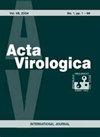Comprehensive codon usage analysis of the African Swine Fever Virus
IF 0.8
4区 医学
Q4 VIROLOGY
引用次数: 0
Abstract
The non-uniform usage of synonymous codons occurs in genomes of all organisms, including DNA and RNA viruses. The preferential selection of a codon at the expense of other synonymous codons within the same group is known as Codon Usage Bias. The understanding of this bias assists in unveiling the factors driving molecular evolution, as defined by the selection-mutation-drift theory. According to this model, molecular evolution is predominantly driven by mutation, natural selection, and genetic drift. Nevertheless, elements like nucleotide composition, gene length, and protein secondary structure also contribute to this process. Comprehensive genomic analyses that highlight the codon usage preference of the African Swine Fever Virus (ASFV) are infrequent. ASFV, a hemorrhagic and highly contagious viral disease, almost invariably results in 100% fatality among infected pigs and wild boars. This study, therefore, embarked on a thorough examination of codon usage patterns in ASFV’s complete genomic sequences, an endeavor of great relevance to molecular evolution studies, complex transmission models, and vaccine research. For an exhaustive evaluation of ASFV’s whole-genome codon usage, we used parameters like ENC, RSCU, and CAI. A Principal Component Analysis was carried out to reaffirm the interconnected RSCU lineages based on the continent, and their evolutionary relationships were later elucidated through phylogenetic tree construction. ASFV emerged as a low-biased codon user (ENC = 52.8) that is moderately adapted to its host. Its genome has a high AT composition (64.05%), suggesting the impact of mutational pressure on genomic evolution. However, neutrality plot analysis revealed natural selection’s slight supremacy over mutational pressure. The low codon bias (>45) implies ASFV’s diverse usage of synonymous codons within a given codon family, allowing for effective translation and subsequent successful viral replication cycles. Its moderate adaptation (CAI = 0.56) permits the virus to infect a range of hosts, including reservoirs such as warthogs and bush pigs. To the best of our knowledge, this is the pioneering report providing a comprehensive examination of ASFV’s complete genomic sequences. Consequently, research focusing on viral gene expression and regulation, gene function prediction, parasite-host interaction, immune dysfunction, and drug and vaccine design may find this report to be a valuable resource.非洲猪瘟病毒密码子使用的综合分析
同义密码子的不均匀使用发生在所有生物体的基因组中,包括DNA和RNA病毒。密码子的优先选择以牺牲同一组内其他同义密码子为代价被称为密码子使用偏差。对这种偏见的理解有助于揭示驱动分子进化的因素,正如选择-突变-漂移理论所定义的那样。根据这个模型,分子进化主要是由突变、自然选择和遗传漂变驱动的。然而,核苷酸组成、基因长度和蛋白质二级结构等因素也有助于这一过程。强调非洲猪瘟病毒(ASFV)密码子使用偏好的全面基因组分析并不常见。非洲猪瘟是一种出血性和高度传染性的病毒性疾病,在受感染的猪和野猪中几乎总是导致100%的死亡率。因此,本研究开始了对非洲猪瘟全基因组序列密码子使用模式的深入研究,这一努力与分子进化研究、复杂传播模型和疫苗研究具有重要意义。为了全面评估ASFV的全基因组密码子使用情况,我们使用了ENC、RSCU和CAI等参数。通过主成分分析,确认了基于大陆的RSCU相互关联的谱系,并通过系统发育树的构建阐明了它们的进化关系。ASFV作为低偏密码子使用者出现(ENC = 52.8),对其宿主具有适度的适应性。其基因组具有较高的AT组成(64.05%),表明突变压力对基因组进化的影响。然而,中性图分析显示自然选择略高于突变压力。低密码子偏差(>45)意味着ASFV在给定密码子家族中对同义密码子的不同使用,允许有效的翻译和随后成功的病毒复制周期。它的中等适应性(CAI = 0.56)允许病毒感染一系列宿主,包括疣猪和丛林猪等宿主。据我们所知,这是一份开创性的报告,提供了非洲猪瘟完整基因组序列的全面检查。因此,关注病毒基因表达和调控、基因功能预测、寄生虫-宿主相互作用、免疫功能障碍以及药物和疫苗设计的研究可能会发现本报告是一个有价值的资源。
本文章由计算机程序翻译,如有差异,请以英文原文为准。
求助全文
约1分钟内获得全文
求助全文
来源期刊

Acta virologica
医学-病毒学
CiteScore
3.10
自引率
11.80%
发文量
43
审稿时长
>12 weeks
期刊介绍:
Acta virologica is an international journal of predominantly molecular and cellular virology. Acta virologica aims to publish papers reporting original results of fundamental and applied research mainly on human, animal and plant viruses at cellular and molecular level. As a matter of tradition, also rickettsiae are included. Areas of interest are virus structure and morphology, molecular biology of virus-cell interactions, molecular genetics of viruses, pathogenesis of viral diseases, viral immunology, vaccines, antiviral drugs and viral diagnostics.
 求助内容:
求助内容: 应助结果提醒方式:
应助结果提醒方式:


